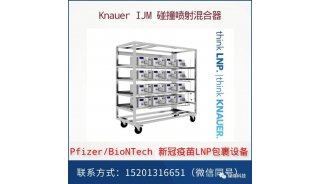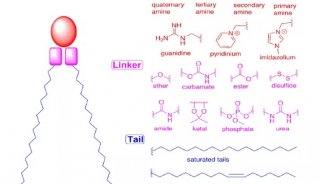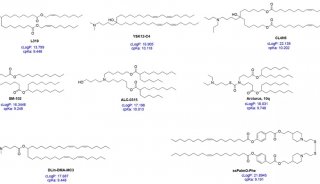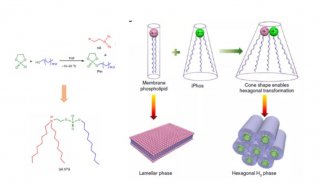GFP-Trap如何设计成功的IP实验?
借助Chromotek公司GFP-Trap如何设计成功的IP实验?
How to plan an immunoprecipitation of your GFP-fusion protein when using the ChromoTek GFP-Trap®
Preamble
This document provides practical information on how to apply the ChromoTek GFP-Trap® for immunoprecipitation.
Introduction
The ChromoTek GFP-Trap® is based on a GFP-binding protein derived from an Alpaca
single
variable domain antibody, also called VHH or nanobody (figure 1). The
GFP-Trap has particular properties and provides some advantages over
traditional IgG antibodies when applied in immunoprecipitations.

Planning of the experiment
There are some
experimental aspects that you should consider when planning
immunoprecipitation of your GFP-fusion protein of interest using the
ChromoTek GFP-Trap®. Below, we guide you through each step.
There are 3 matrices available:
| Feature | Agarose beads | Magnetic agarose beads | Magnetic beads |
| Matrix | Agarose, 4% highly cross-linked | Agarose, 6% cross-linked | Silica, non-porous |
| Partical size | 45-165μm | 20-40μm | 0.5-1μm |
| Binding capacity | 2-3μg per 10μl bead slurry | 2-3μg per 10μl bead slurry | 0.5μg per 10μl bead slurry |
| Magnetic | no | yes | yes |
Pre-clearing:
Pre-clearing is an optional step to remove proteins
or DNA which bind non-specifically to the solid-phase support. It
includes the incubation of the cell extract with plain beads
(e.g.binding control agarose beads) before performing the actual
immunoprecipitation experiment with the GFP-Trap. After successful
pre-clearing, non-specific proteins or other components will not be
co-purified with the protein of interest.
CRAPome:
By nature, every matrix and binding molecule may nonspecifically bind some proteins
resulting in protein background. Scientists have established the internet-based database
CRAPome at www.crapome.org. This database stores and annotates negative controls
generated by the proteomics research community. CRAPome helps to determine the
background contaminants--for example, proteins that interact with the solid-phase support,affinity reagent or epitope tag.
Specificity - What fluorescent proteins are captured by the GFP-Trap®
The GFP-Trap® specifically binds to most of the common GFP derivatives:
| Fluorescent protein | GFP-Trap® | Fluorescent protein | GFP-Trap® | |
| (e)GFP | √ | (e)Citrine | √ | |
| tagGFP2 | √ | AcGFP | √ | |
| turboGFP | - | Superfolder GFP | √ | |
| mClover | √ | mCerulean | √ | |
| YFP | √ | pHluorin | √ | |
| CFP | √ | GFP S65T | √ | |
| Venus | √ | - | - |
The ChromoTek GFP-Trap® only binds properly folded active GFP. It is
believed that this is because that nanobody binds to a three-dimensional
epitope of GFP. The nanobody’s
elongated CDR3 (complementarity determining region 3) allows to reach into clefts and
enzymatic
centers of proteins, which are not accessible to conventional
antibodies but results in very strong binding and very low dissociation
constants of this GFP nanobody. Therefore that anti-GFP nanobody is not
suitable for protein detection in Western Blots. For Western Blot
detection of GFP (fusion proteins) ChromoTek recommends the traditional
antibody anti-GFP antibody 3H9 (rat monoclonal, see complementary
products).
Controls – What controls should I conduct to validate the experimental data?
Below find some suggestions by application:
For Immunoprecipitation (IP):
• GFP-Trap® for IP of GFP-fusions and a non-relevant Nano-Trap as negative control,
e.g. Myc-Trap®, GST-Trap or MBP-Trap
For Co-Immunoprecipitation (Co-IP) of protein complex AB:
Cell Lysis – What to consider when preparing a cell lysate?
Lysis buffers:
• A non-denaturing lysis buffer is suitable for Co-IP, because proteins will remain in
their native conformation
• The RIPA (Radio Immunoprecipitation Assay) buffer might denature proteins or
disrupt protein complexes
Inhibitors:
• Add protease inhibitors to prevent proteolysis!
• Preserve posttranslational modifications of your protein and add e.g. phosphatase
inhibitors!
• Prevent degradation of your protein by keeping your samples on ice!
Immunoprecipitation – Binding of the GFP-fusion
Since
the GFP binding protein is covalently coupled to the beads’ surface,
the GFP-Trap®beads are ready-to-use and can be directly added to the
prepared lysate. The affinity ofGFP-nanobody is in the picomolar range,
therefore depletion of GFP-fusions can becompleted within 5-30 minutes.
Buffer compatibility of the GFP-Trap® for binding and washing
The GFP-Trap® is compatible with most wash buffers and stable under harsh conditions
including:
• Up to 1 M NaCl and 8 M Urea
• Up to 0.2% SDS and 2% NP-40
Elution strategies
The elution of the bound GFP-fusion protein by a competitive peptide, which replaces the
GFP-fusion
protein doesn’t work. Also, the addition of chaotropic compounds like
urea don’telute the bond GFP-fusion protein as the GFP-Trap® works under
denaturing conditions. We therefore recommend to elute with:
• SDS, e.g. SDS sample buffer, is a very effective way to elute the bound GFP-tagged
protein. The elution results in denatured GFP-fusions.
• 0.2 M glycine pH 2.5
Alternatively you may elute with glycine at pH 2.5. It is recommended to repeat this
elution step as the pH shift elution works incompletely. The repetition will improve the
elution efficiency.
Very important: Don’t forget to neutralize proteins immediately after elution!
As an alternative to above elution options, a protease cleavage site
between GFP and the fusion protein can be introduced. This option is
recommended if less stable proteins have
been bound or if you want to enrich your native protein of interest.
Furthermore, consider whether you really need to elute the bound protein of interest from the beads rather than conduct the downstream analysis “on-bead”:
• Proteins can be digested when still coupled to the beads for subsequent mass
spectrometry analysis.
• Enzymatic activity assays can be performed when still coupled to the beads if the
active center is not blocked.
Reproducibility
The GFP-Trap® is a small, soluble
and stable single polypeptide chain that is recombinantly expressed in
bacteria. This in combination with quality control makes its production
robust and reproducible for reliable results.
Selected References to introduce Nanobodies and their applications:
Nanobodies as probes for protein dynamics in vitro and in cells
Dmitriev, O. Y., Lutsenko, S. and Muyldermans, S. in: Journal of Biological Chemistry, 2015 – jbc-R115.
A versatile nanotrap for biochemical and functional studies with fluorescent fusion proteins
Rothbauer,
U., Zolghadr, K., Muyldermans, S., Schepers, A., Cardoso, M. C.,
Leonhardt, H. in: Mol Cell Proteomics, 2008 Feb;7(2):282-9. Epub 2007
Oct 21
Nanobody-based products as research and diagnostic tools
De Meyer, T., Muyldermans,S. and Depicker, A. in: Trends in Biotechnology, 2014 May; 32 (5): 263-270;
Beneficial properties of single-domain antibody fragments for
application in immunoaffinity purification and immuno-perfusion
chromatography
Verheesen P., Ten Haaft M. R., Lindner N., Verrips C.T., de Haard J. J. W. in: Biochim. Biophys. Acta, 2003; 1624(1–3): 21–28
A highly specific gold nanoprobe for live-cell single-molecule imaging
Leduc,
C., Si, S., Gautier, J., Soto-Ribeiro, M., Wehrle-Haller, B., Gautreau,
A., .Giannone, G., Cognet, L. & Lounis, B. in:
Nano letters, 2013: 13(4), 1489-1494.
Nanobody-based chromatin immunoprecipitation.
Duc, T. N., Hassanzadeh-Ghassabeh, G., Saerens, D., Peeters, E., Charlier, D., & Muyldermans, S. in:
Single Domain Antibodies: Methods and Protocols, 2013: 491-505
| Product name | Size | Code |
| GFP-Trap® A ▶coupled to agarose beads | 10 rxns(250µl resin) | gta-10 |
| 20 rxns(500µl resin) | gta-20 | |
| 100 rxns(2.5ml resin) | gta-100 | |
| 200 rxns(5ml resin) | gta-200 | |
| 400 rxns(10ml resin) | gta-400 | |
| GFP-Trap® A Kit ▶GFP-Trap® A ▶incl.lysis wash and elution buffers | 20 rxns(500µl resin) | gtak-20 |
| GFP-Trap® MA ▶coupled to magnetic agarose beads | 10 rxns(250µl resin) | gtma-10 |
| 20 rxns(500µl resin) | gtma-20 | |
| 100 rxns(2.5ml resin) | gtma-100 | |
| 200 rxns(5ml resin) | gtma-200 | |
| 400 rxns(10ml resin) | gtma-400 | |
| GFP-Trap® MA Kit ▶GFP-Trap® MA ▶incl.lysis,wash and elution buffers | 20 rxns(500µl resin) | gtmak-20 |
| GFP-Trap® M ▶coupled to magnetic particles | 10 rxns(250µl resin) | gtm-10 |
| 20 rxns(500µl resin) | gtm-20 | |
| 100 rxns(2.5ml resin) | gtm-100 | |
| 200 rxns(5ml resin) | gtm-200 | |
| 400 rxns(10ml resin) | gtm-400 | |
| GFP-Trap® M Kit ▶GFP-Trap® M ▶incl.lysis,wash and elution buffers | 20 rxns(500µl resin) | gtmk-20 |
| GFP- multi Trap® ▶black 96 well plate | 96 rxns(1 plate) | gtp-96 |
| 480 rxns(5 plate) | gtp-480 | |
| GFP-Trap® ▶uncoupled protein | 250µl | gt-250 |
| Spin columns | 10 units | sct-10 |
| 20 units | sct-20 | |
| 50 units | sct-50 | |
| Binding control ▶agarose beads | 500µl(20 rxns) | bab-20 |
| Binding control ▶magnetic agarose beads | 500µl(20 rxns) | bmab-20 |
| Binding control ▶magnetic particles | 500µl(20 rxns) | bmp-20 |
| GFP antibody(3H9) ▶rat monocional | 100µl | 3H9 |















